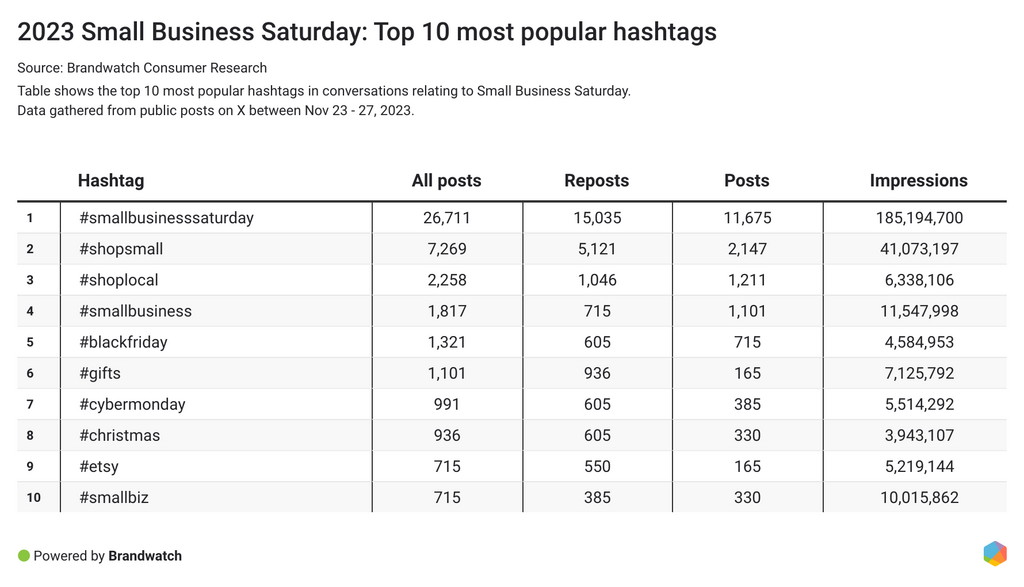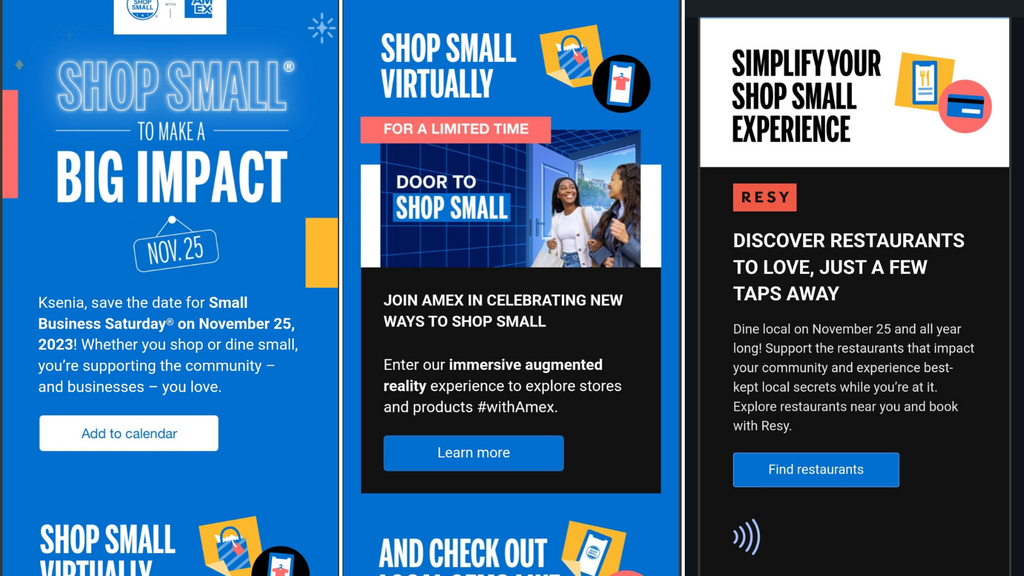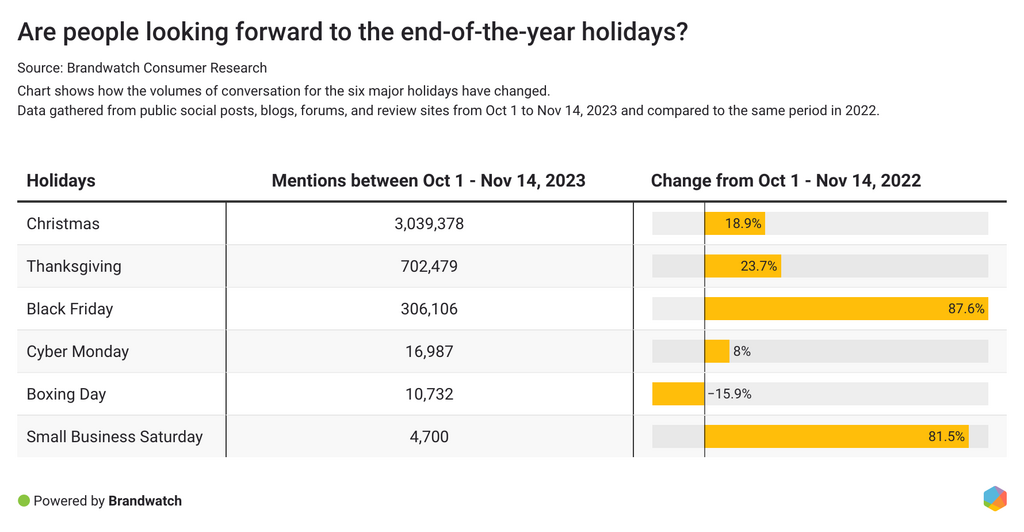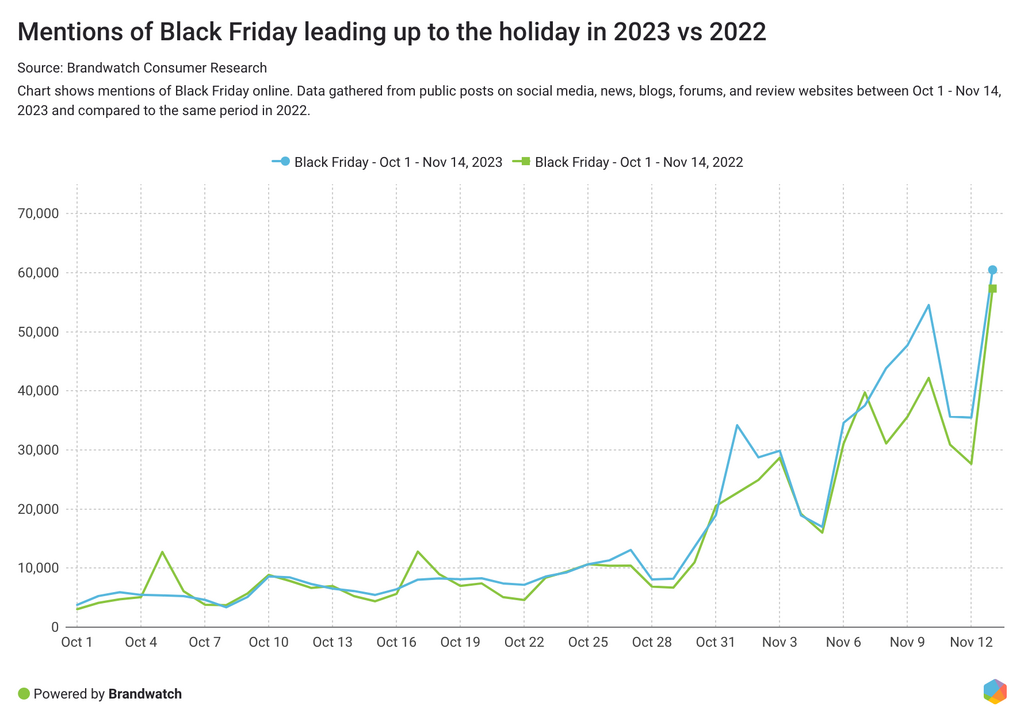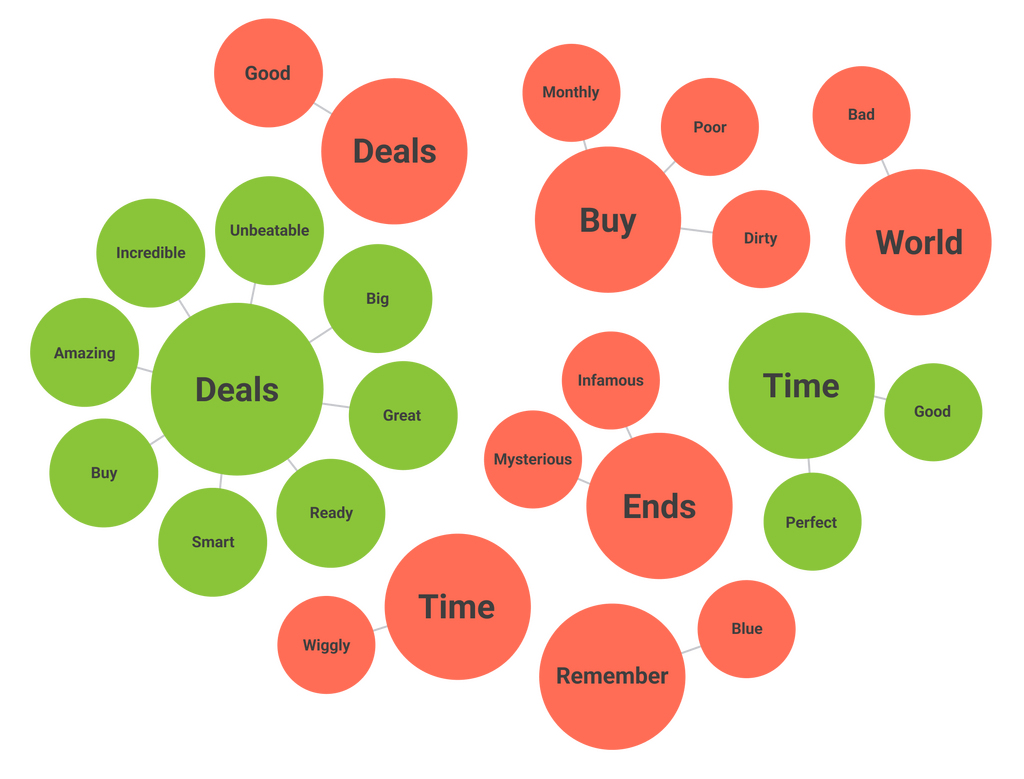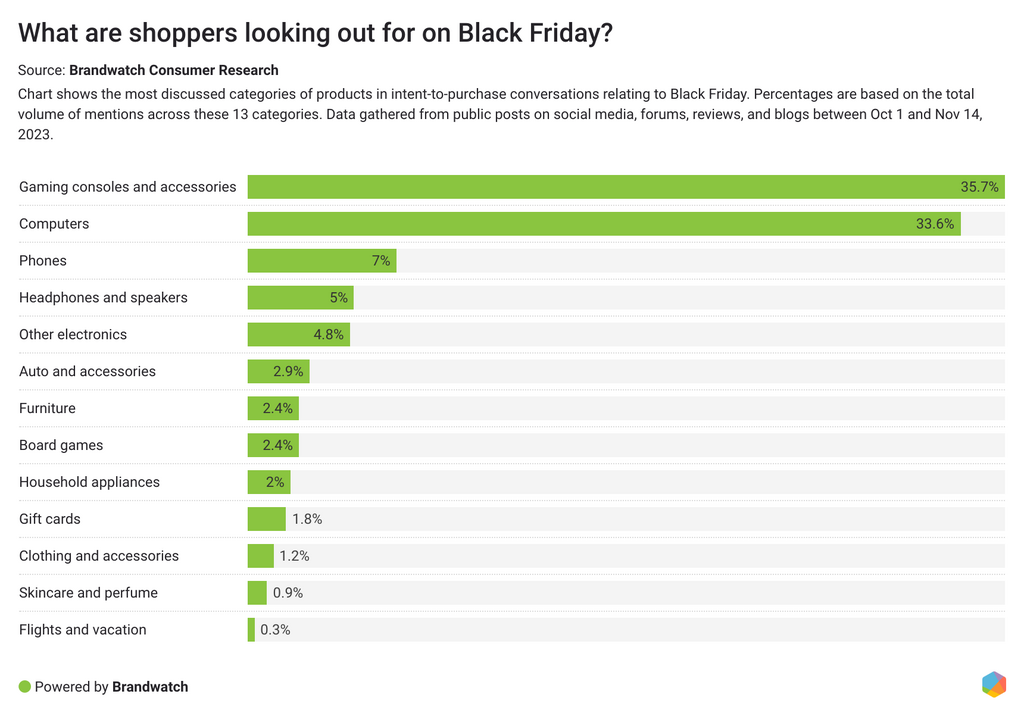This year’s November holiday sales have been reported to be increasingly online.
With that in mind, we tracked online mentions relating to Black Friday, Small Business Saturday, and Cyber Monday between November 23 and 27, 2023, producing 2.83m mentions to analyze.
This year’s holiday weekend has gathered 42% more mentions than last year’s between November 24 and 28, 2022 (up 840k mentions from 1.99m).
With the retail holiday season at full speed, let’s recap some stats.
You can also read our pre-Black Friday analysis below.
Black Friday 2023: Top-line stats
Mentions of Black Friday alone accounted for 89% of the entire conversation relating to the three holidays.
- Black Friday has gathered 2.49m mentions between November 23-27, 2023 – up 46% from last year’s Black Friday event.
- There were 2.02m unique authors posting about Black Friday – up 57% from the same period in 2022 (1.29m).
- Most (66%) of Black Friday mentions came from the United States.
- The UK was second, followed by Canada, with 8% and 3% of all the posts, respectively.
Mixed sentiments around Black Friday
Our emotion analysis showed that while joy was the most prevalent emotion in the Black Friday conversation between November 24 – 27, 2023, angry mentions saw the highest increase in volume – up 445% from the previous five days.
The spike in grocery mentions we reported in our pre-Black Friday analysis has carried into the Black Friday conversation, with many people still reposting this message.
Some consumers online have voiced a loss of trust in Black Friday as an event for shopping deals and towards the companies that participate.
In a post here, a video shows a shopper in a store moving aside a Black Friday "deals" sign, only to find that the regular price listed behind it is the same as the offer.
“I don’t get it. I’m confused,” the consumer is heard saying in the video. The post has received 3m views on X so far.
Some savvy influencers took matters into their own hands, exposing misleading advertising tactics and teaching the public how not to fall for fake deals.
TikTok influencer Miki Rai, with a following of 2.5m, has published a video teaching her followers how to verify that online deals are, in fact, discounts and not markups made by companies ahead of the big holiday season.
Buy Nothing Day
“Buy Nothing Day is easy when you don’t have any money,” this consumer on X seemed to strike a chord with many.
An initiative protesting against consumerism has gathered close to 3k mentions between November 23 and November 27, 2023 – a subtle increase of 3% compared to last year.
To honor Buy Nothing Day, many cause-driven organizations joined the online calls for more intentional spending, including Greenpeace, Films For Action, Fridays for Future Helsinki, Wildlife Conservation Society Canada, and Green Action Centre.
While many consumers shared their support towards Buy Nothing Day as well, some added that it’s highly important to support small and local businesses on this day. This person’s post generated a lot of engagement on X.
Small Business Saturday: Top-line stats
How did the “shop small” day fare with consumers online?
Sandwiched between Black Friday and Cyber Monday, Small Business Saturday is a marketing initiative created by American Express to encourage holiday shopping and boost small businesses.
According to American Express’s Shop Small Impact 2023 study, 80% of the survey respondents agreed that small businesses are essential to their communities. 51% said they prefer to shop with small businesses during the holiday shopping season.
Small Business Saturday has generated more discussions this year compared to 2022.
Between November 23–27, 2023, Small Business Saturday:
- Clocked in 104.2k mentions – up 33% from last year’s event.
- The shop-small conversation has engaged fewer unique authors this year compared to 2022 – 59.5k authors, down 13% from 68.24k last year.
- The conversation has been mostly positive (43% of all sentiment-categorized mentions), with negative mentions accounting for only a small fraction of the conversation (2% of all sentiment-categorized mentions).
The top 10 hashtags in conversations about Small Business Saturday
Besides the official hashtags for Small Business Saturday, our analysis also surfaced mentions of #gifts and #etsy in conversations relating to shopping small.
Many of these mentions showcased small businesses and entrepreneurs using this opportunity to promote and build more awareness about their online shops and offerings.
Boosting “shop small” this November
There’s room for larger organizations to participate in Small Business Saturday, too. For example, American Express encourages their users to shop small and with local partners using their platform.
Many other organizations have joined the calls to boost shopping small and local. Some highlighted small businesses to support or promote their preferred local shops.
Other companies opted for a simple reminder about the benefits of supporting local vendors.
Larger companies don’t always have to get creative when joining a social cause. Aligning your values with those of your consumers in an authentic way is a step in the right direction.
Cyber Monday 2023: Top-line social media stats
How did 2023 Cyber Monday go online?
Looking at the five days’ worth of data (November 23-27, 2023),
- Cyber Monday tracked 363.4k mentions – up 25% from last year’s event.
- We also tracked 289.3k unique authors – up 30% from the same period in 2022 (222.62k).
Brands joining in on the Cyber Monday conversation
One way to promote your product is by showing massive value to your consumers when they need it most – during the holiday shopping season.
In this example, Microsoft promoted Edge on Cyber Monday by encouraging consumers to check the authenticity of deals online using their product.
This year’s Cyber Monday has broadened its focus beyond electronics, seizing another chance for companies to get in front of consumers and generate revenue.
Consumers reacting to Cyber Monday deals
Similar to our pre-Black Friday analysis, consumers sensed the pressure from companies to push for sales.
And some people displayed hesitation about senselessly buying more, limiting their purchases to something they really need and use.
The power of “unsubscribe”
The marketing overload seemed to take a toll on consumers, with some people sharing their plans to unsubscribe from receiving marketing emails.
This may signal potential marketing fatigue among consumers. To stay ahead in 2024, brands need to rethink their strategies to ensure the right balance between staying top of mind and not putting off their audience.
For more information on how to succeed next year, read our 2024 Digital Trends Report.
What can brands learn from the November holidays data?
As the holiday season rolls along, brands need to make decisions based on real-time data. Regardless of the industry, consumers are increasingly online; they share their preferences, yeas and nays, and lots of valuable feedback for brands.
Brands that can incorporate real-time consumer insights into their strategies will strengthen their position in the market. Having the right data at hand is the golden ticket for brands and marketers looking to succeed this holiday season.
An Early Look at the Black Friday Shopping
The inflation rate worldwide has gone down since mid-2022, but consumers are still concerned about their financial stability in this economy.
According to a recent McKinsey study, 79% of US consumers are planning to buy cheaper alternatives during the holidays or abstain from buying anything altogether – this trend is up 5% from 2022.
Other analysts have shared similar predictions, citing consumer spending slowing down this holiday season.
With this in mind, we dove into the social media data to discover consumer sentiments around the upcoming holidays.
Are people looking forward to the holiday shopping?
We compared the volume of mentions around the six major holiday shopping events between October 1 and November 14, 2023 and the same period in 2022.
While Christmas gathered the highest volume of mentions, the pre-Black Friday conversation is definitely bigger this year (up 24% compared to 2022).
Small Business Saturday has gathered more mentions this year so far, too, but the volumes of conversation are still premature (under 5k).
How do emotions in conversations compare?
We looked at emotions in conversations relating to the six holidays.
Joyful mentions accounted for over 50% of discussions about the upcoming holidays, with Thanksgiving and Small Business Saturday leading the way at 88% and 74%, respectively.
In those conversations, consumers frequently discussed their positive shopping experiences, including satisfaction with the products available and the customer service, Some also made personal recommendations, which included asking for and suggesting Christmas gift ideas.
But not everyone is happy, especially not with Christmas approaching so rapidly. In negative conversations, many consumers mentioned their discontent with Christmas sales and promos starting too early.
The Black Friday conversation
Holiday sales starting earlier seemed to be an overarching theme in many holiday-related conversations.
With the rising costs of materials and labor, corporations are pushing harder to increase profit margins. And it appears that many brands have jumped on the holiday marketing bandwagon way earlier this year, prompting some consumers to call this move “desperate.”
We looked back to 2017, and overall, the Black Friday conversation continues to (except for a slight increase in 2022) decline year over year.
Yet, the Black Friday conversation has seen more mentions between October 1 and November 14, 2023 than during the same period last year, up 21%.
The surge in the volume of mentions in the first two weeks of November 2023 looks pretty promising for retailers.
What are the prevalent themes in the Black Friday conversations online this year?
We visualized the Black Friday conversation in a topic cloud, and, as expected, “deals” were prominent in both negative (red) and positive (green) discussions.
Consumer sentiments around Black Friday deals
Sentiment in conversations around Black Friday deals this year is almost identical to 2022. Between October 1 and November 14, 2023, “deals” accumulated 12% of positive mentions and 7% of negative mentions, compared to 11% and 6%, respectively, for the same period last year.
In positive Black Friday conversations, consumers enthusiastically discussed various online retail platforms offering Black Friday deals and emphasizing the convenience of shopping and finding discounts online.
Some shoppers encouraged others to start their holiday shopping early and take advantage of the many Black Friday deals and discounts already available.
Negative discussions were driven in part by the anxiety around the rising cost of living. With food prices increasing, many consumers took to social media to criticize the increasing consumerism linked with Black Friday. Some people urged companies to cut prices on food instead of electronics.
Between October 1 and November 14, 2023, we tracked 15.4k mentions of food and groceries in conversations relating to Black Friday deals and sales, a 494% increase from the previous period.
In addition to referencing groceries in cost-related conversations, consumers also mentioned rent, gas, and electricity.
As prices remain elevated and credit card debt in the United States has reached a record high, price-sensitive consumers are keeping an eye out for deals, with some opting to postpone or abstain from Black Friday shopping altogether.
What are consumers planning to buy on Black Friday?
We examined mentions expressing intent to purchase in conversations about Black Friday in the weeks leading up to the event (between October 1 and November 14, 2023). Electronics overwhelmingly took center stage in those discussions, with gaming consoles and accessories topping the list.
How can brands use this information?
Brands should pay attention to changing consumer sentiments, particularly during the holidays. Use holiday marketing strategies to spark consumer interest without overwhelming them with the volume of offers too early.
Companies that understand what’s on the consumer’s shopping list can better align their promotions with consumer preferences. And highlighting online shopping convenience can help attract consumers looking for a hassle-free shopping experience.
